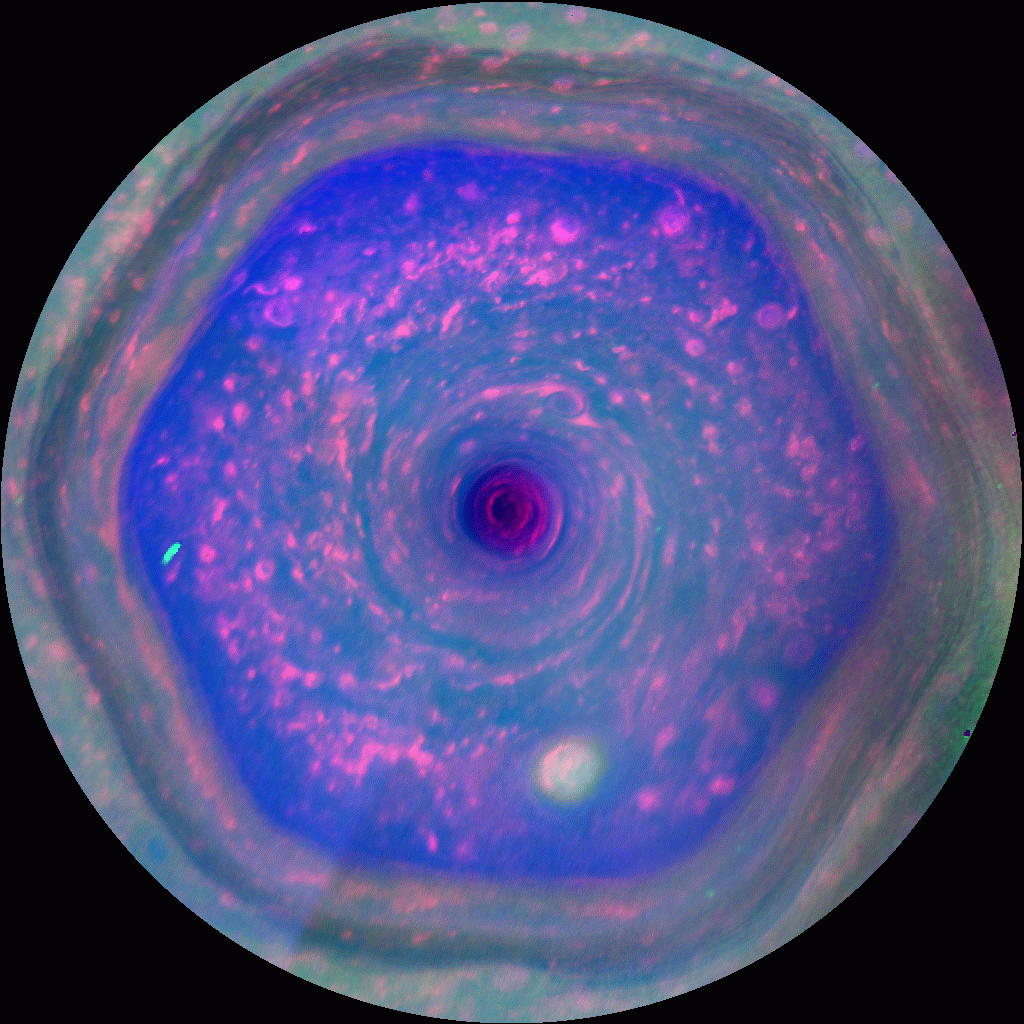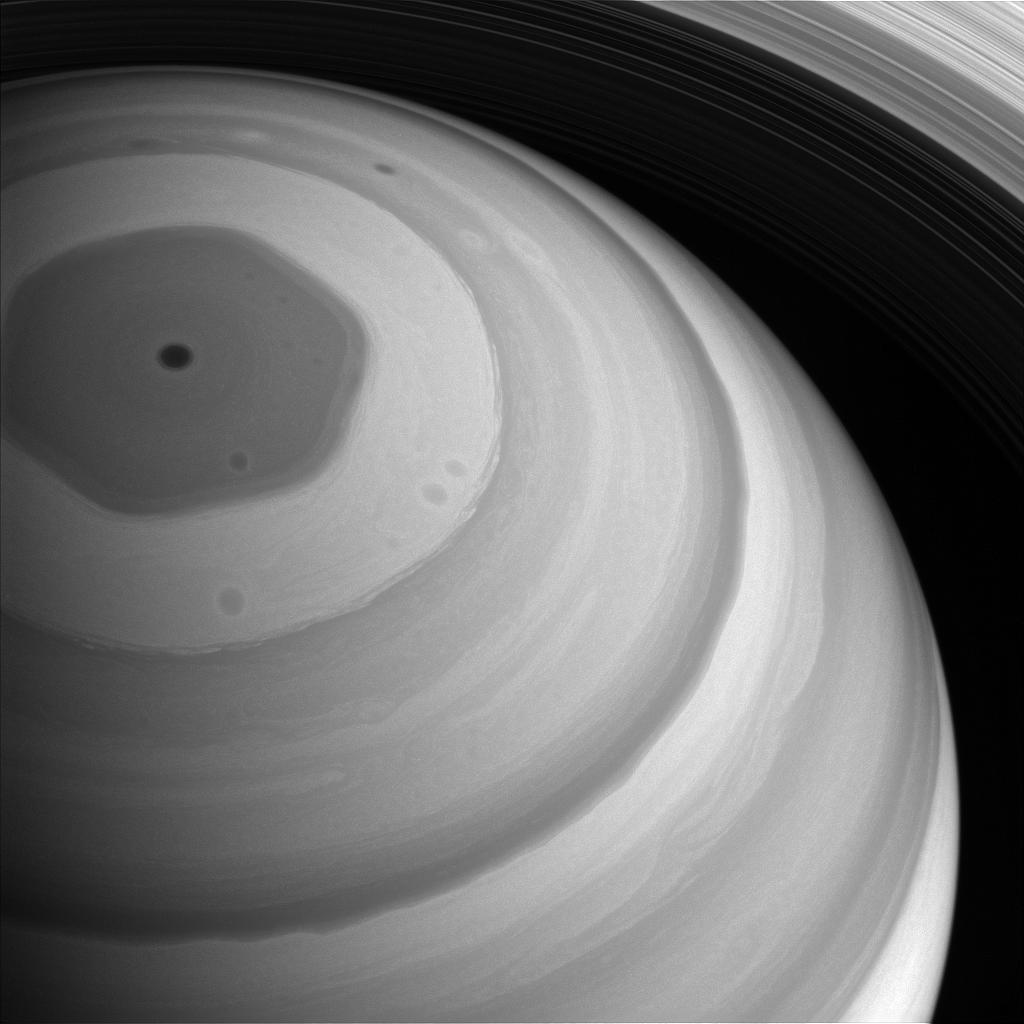Saturn Sprouts Another Weird Hexagon, Puzzling Scientists

A bizarre, hexagon-shaped vortex has formed above Saturn's north pole as the planet's northern hemisphere enters summer, data from the international Cassini-Huygens mission revealed. The unusual vortex is circulating hundreds of kilometers above the clouds in the stratosphere layer of the ringed planet's atmosphere, a new study reported.
This warm polar vortex resembles another, previously discovered hexagon formation, also located at Saturn's north pole, but lower in the atmosphere. But how and whether these bizarre low- and high-altitude hexagons are related remains a mystery to scientists.
"Either a hexagon has spawned spontaneously and identically at two different altitudes, one lower in the clouds and one high in the stratosphere, or the hexagon is in fact a towering structure spanning a vertical range of several hundred kilometers," Leigh Fletcher, lead author of the study and planetary scientist at the University of Leicester in England, said in a statement. [Cassini's Greatest Hits: Best Photos of Saturn and Its Moons]
NASA's Cassini spacecraft arrived at the Saturn system in 2004, when it was summer in the planet's southern hemisphere and winter in the northern hemisphere. At the time, the spacecraft documented a circular, warm, high-altitude vortex at Saturn's south pole but nothing at the north pole.
Prior to Cassini, NASA's Voyager spacecraft had revealed a lower-altitude north-pole hexagon in the 1980s. That hexagon is a long-lasting wave thought to be related to Saturn's rotation, similar to the way Earth's rotation influences the Polar Jet Stream.
The Cassini spacecraft took a closer look at this previously discovered lower-altitude hexagon formation with several instruments, including the Composite Infrared Spectrometer (CIRS) — a device that measures the temperature and composition of objects by capturing infrared light, according to NASA.

But because it was winter in Saturn's northern hemisphere at that time, temperatures in the stratosphere above the north pole were around minus 252 degrees Fahrenheit (minus 158 degrees Celsius) — too cold for reliable CIRS observations. The extreme temperatures meant Cassini had to wait for summer, and as a result, the high-altitude regions of Saturn's north pole went unexplored for years.
Sign up for the Live Science daily newsletter now
Get the world’s most fascinating discoveries delivered straight to your inbox.
"One Saturnian year spans roughly 30 Earth years, so the winters are long," Sandrine Guerlet, study co-author and planetary researcher at the Dynamic Meteorology Library in France, said in the statement. "Saturn only began to emerge from the depths of northern winter in 2009 and gradually warmed up as the northern hemisphere approached summertime," Guerlet explained.
Years later, as temperatures in Saturn's northern hemisphere gradually increased, Cassini's CIRS discovered the strange polar vortex high above the north pole. "As the polar vortex became more and more visible, we noticed it had hexagonal edges," Guerlet said.
Cassini captured images of both a low-altitude and high-altitude hexagon-shaped vortex only at Saturn's north pole, while the vortex discovered years earlier at Saturn's south pole was circular. This discrepancy between Saturn's poles led the researchers to suspect that there are likely different processes at work at the planet's two poles. The different vortexes suggest that the poles are asymmetrical or that the north pole vortex was still developing and continued developing after Cassini's demise in Sept. 2017, Fletcher said.
It's unlikely that the newly described vortex is arising from a single, giant hexagonal column of clouds above Saturn's north pole, because the planet's winds change drastically with altitude. And Fletcher and his colleagues previously thought that waves, like those from the earlier-discovered north pole hexagon, couldn't propagate upwards, so would remain trapped in the cloud-tops.
But Saturn presents a potential anomaly in how waves behave.
"One way that wave 'information' can leak upwards is via a process called evanescence, where the strength of a wave decays with height but is just about strong enough to still persist up into the stratosphere," Fletcher said.
Unraveling the mystery of how Saturn's high-altitude hexagon vortex formed may help scientists learn more about atmospheric effects, such as how events lower in an atmosphere affect the environment at higher altitudes.
"We simply need to know more," Fletcher said.
The team published its results Monday (Sept. 3) in the journal Nature Communications.
Original article on Live Science.

Kimberly has a bachelor's degree in marine biology from Texas A&M University, a master's degree in biology from Southeastern Louisiana University and a graduate certificate in science communication from the University of California, Santa Cruz. She is a former reference editor for Live Science and Space.com. Her work has appeared in Inside Science, News from Science, the San Jose Mercury and others. Her favorite stories include those about animals and obscurities. A Texas native, Kim now lives in a California redwood forest.










